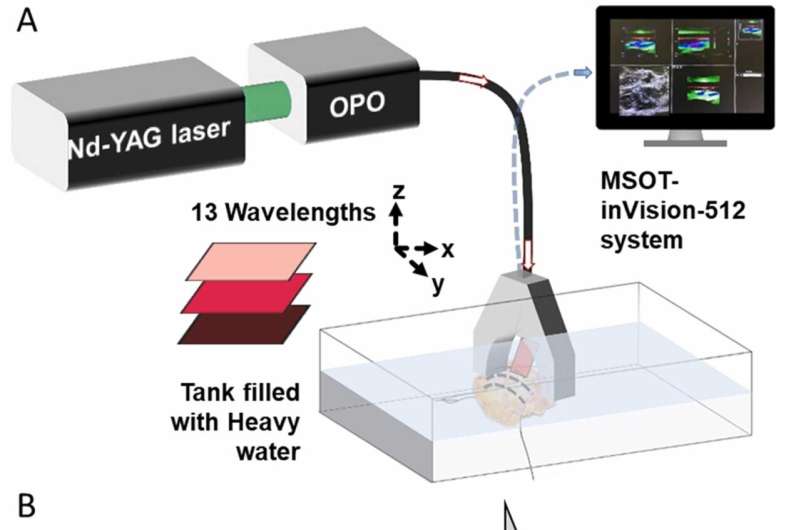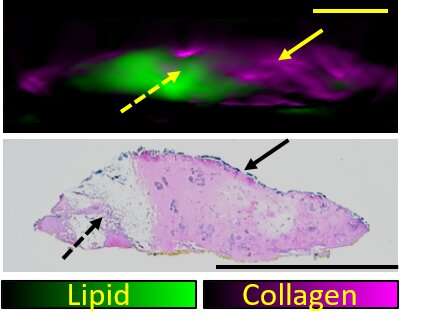How optoacoustic imaging plays a role in assessing the success of breast cancer surgery

A study has explored the benefits of using optoacoustic imaging to ascertain the complete removal of cancerous breast lesions. Optoacoustic imaging is a hybrid technology that uses both laser and ultrasound imaging to offer a critical layer of information that complements the current methods of verifying complete tumor excision such as X-rays or ultrasound.
This first-in-human study was carried out by a team of researchers and clinicians at A*STAR's Institute of Bioengineering and Bioimaging (IBB) and the National University Hospital (NUH) since 2017, with patients recruited through the National University Cancer Institute, Singapore. The study is published in the journal Photoacoustics.
Breast conserving surgeries are often performed to remove and treat early-stage cancers. However, there is a possibility of incomplete excision and a need for reoperation, which affects about 15% of patients who undergo the surgery. The objective of this imaging technology is to help breast surgeons in the operating theater with the complete removal of cancer tissues and give patients the best chance at a successful breast conserving surgery, preventing the need for reoperation.
Currently, clinicians use conventional specimen imaging equipment like X-rays or ultrasound, which is conducted after the surgery. However, these technologies do not detect subtle or tiny cancer cells that could indicate incomplete excision of cancer. If the surgeon is able to determine an incomplete excision of the tumor during the operation, they could continue to remove the leftover cancerous tissues.
The researchers have demonstrated earlier that photoacoustically-derived distribution of fat and blood in the excised specimen showed distinct patterns in those specimens where the tumor was completely excised (negative margin specimens); compared to those that have tumor remnants (positive margin specimens).

In breasts, collagen is one of the major structural components of the tissue architecture and also an important component of the cancer microenvironment. In addition to imaging fat and blood of varying oxygenation status, being able to image the distribution of collagen in breast tissue allows for greater accuracy in assessing the success of the surgery.
Dr. Gayathri Balasundaram, Research Scientist at A*STAR's IBB said, "We worked together with breast radiologists and surgeons from the National University Hospital to demonstrate proof of concept of photoacoustic imaging to assess the success of breast cancer surgery. These findings could help in further development of an accurate surgical margin assessment tool that can provide intraoperative feedback, which would enhance the success of breast surgery. This could help to reduce reoperation and prevent further psychological stress for patients."
Prof Malini Olivo, Senior Principal Investigator at A*STAR's IBB added, "The novel photoacoustic ultrasound hybrid imaging technology developed at IBB's Translational Biophotonics lab could be game changing to identify both structural and intrinsic biomarkers that determine cancer margins during breast cancer surgery."
The Principal Investigator of the study, Dr. Goh Yong Geng, who is also a Consultant at the Department of Diagnostic Imaging in NUH said, "Based on our first-in-human study, we have determined that the diagnostic accuracy of this method is about 95 to 99%. This is a very promising imaging technology that can improve the efficacy of breast cancer surgeries. We will continue to leverage this technology for further advancement in improving the efficiency and effectiveness of breast cancer treatment to help save on costs and time for patients and hospital resources."
The team plans to conduct further research using this method of imaging through larger studies in the future.
More information: Yonggeng Goh et al, Biochemical "decoding" of breast ultrasound images with optoacoustic tomography fusion: First-in-human display of lipid and collagen signals on breast ultrasound, Photoacoustics (2022). DOI: 10.1016/j.pacs.2022.100377




















